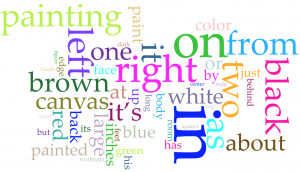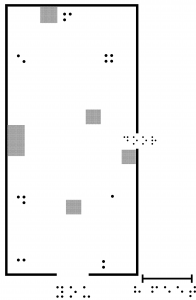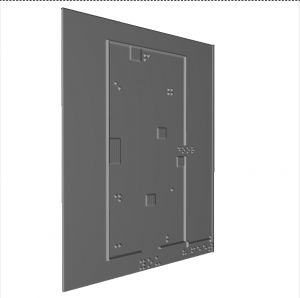Rationale and Development Plan:
- Research into low-vision friendly design
- Focus group with The Iris Network in Portland
- Interviews to test visual descriptions and get user preferences
- Refine visual description from user feedback
- Tactile map for orientation
- Augment tour with touch components
Task: Interview Users who were Blind/Low Vision
- Interviewed Users about Indoor Navigation Applications and Museum Experiences
- Used information from interviews to advise on the design of the Mobile Application and System Functionality/Features
- Checked the accuracy of Personas and assumptions
- Created new tactile guides based on user input
Creation of Personas:
- Persona 1: Carl, normally a screen magnifier/high-contrast user and an art enthusiast
- Carl is 70 years old. Married with two sons and grandchildren
- Carl is retired but used to work in academia as a math professor.
- He frequents art museums and in particular enjoys Renaissance portraits.
- Persona 2: Anna, a screen reader user
- Anna is 25 years old and lives with her parents.
- She is a part-time receptionist in a local authority building in Portland.
- She has begun studying humanities this year at the University of Maine Augusta.
- Persona 3:Lori, recently lost all vision
- 45 years old and lives with her husband and two daughters (12) & (16)
- Uses a guide dog to navigate
- Worked as a teacher until having children, and now is a stay at home mom
Text Analysis:


3D Printed Tactile Map:


Three Tiered Description:
Basic: This painting is titled Apollo and Daphne and was completed by Jacopo da Pontormo in 1513. It is a black and white oil on canvas. It is rectangular in shape. 24 3/8 inches tall by 19 1/4 inches wide. It is displayed in a bright metallic gold wooden frame.
Spatial: The figures are located in the center of the portrait. They take up about 1/2 of the picture. The portrait has Apollo standing in the right of the portrait. He is reaching out to Daphne with his right hand. Daphne is located in the left of the painting. She has her back to Apollo. She is dressed in a flowing fabric. Daphne’s fingers and arms are growing up into tree branches.
In-depth: Pontormo’s haunting rendition of the tragic legend of Apollo and Daphne takes place in a shadowy no where land. This portrait portrays the futile romance between Apollo and Daphne; Apollo is deeply in love with Daphne, a woman who abhors Apollo’s advances. Located in the foreground center, Apollo is dressed in armor reaching out with his right hand towards Daphne’s shoulder. As Apollo reaches out to lay his hand on Daphne, her fingers and arms in the left top background begin transforming into tree branches. In the portrait we witness the initial instant of Daphne’s transformation branches springing upward from her arms while the rest of her body remains in human form. The look of longing on Apollo’s face is apparent, both of them appear to still be moving leftward out of the image, as if in mid-chase. The transformative depiction of Daphne signals the end of the chase as she turns into a tree beginning with her hands and the top of her head. Apollo’s touch reveals the futility of his desire, as well as the violence and persistence with which he pursued Daphne.
Next Steps:
- More focus groups/interviews
- 3D print outlines not reliefs for all paintings
- Descriptions for all paintings
- “Coyote compliant” descriptions
- Convince curators to start writing these descriptions on their own
- Actual user testing